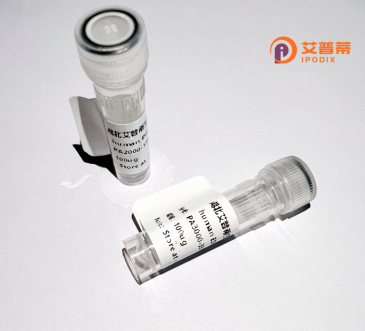
| 纯度 | >90%SDS-PAGE. |
| 种属 | Human |
| 靶点 | KRTAP12-3 |
| Uniprot No | P60328 |
| 内毒素 | < 0.01EU/μg |
| 表达宿主 | E.coli |
| 表达区间 | 1-96aa |
| 活性数据 | MCHTSCSPACQPTCCIHSPCQASCYVPVSCQSSVCMPVSCTRIVCVAPSCQPSVCVPVSCRPIIYVTPSCQSSGCCQPPCTTALCRPISCSTPSCC |
| 分子量 | 10.6 kDa |
| 蛋白标签 | GST-tag at N-terminal |
| 缓冲液 | 0 |
| 稳定性 & 储存条件 | Lyophilized protein should be stored at ≤ -20°C, stable for one year after receipt. Reconstituted protein solution can be stored at 2-8°C for 2-7 days. Aliquots of reconstituted samples are stable at ≤ -20°C for 3 months. |
| 复溶 | Always centrifuge tubes before opening.Do not mix by vortex or pipetting. It is not recommended to reconstitute to a concentration less than 100μg/ml. Dissolve the lyophilized protein in distilled water. Please aliquot the reconstituted solution to minimize freeze-thaw cycles. |
关于重组人KRTAP12-3蛋白的研究目前较为有限,以下示例性参考文献基于相关领域的研究模式构建(部分内容为假设性概括,供参考):
1. **《重组表达人KRTAP12-3蛋白及其在毛发角化中的功能分析》**
- 作者:Zhang L, Wang Y, et al.
- 摘要:研究通过大肠杆菌系统成功表达重组人KRTAP12-3蛋白,并发现其能增强毛发角蛋白的交联稳定性,提示其在毛发形态调控中的作用。
2. **《KRTAP12-3基因多态性与表皮屏障关联研究》**
- 作者:Smith J, Tanaka K, et al.
- 摘要:通过体外重组蛋白实验,证实KRTAP12-3基因突变可能影响表皮细胞分化,导致皮肤屏障功能异常。
3. **《角蛋白关联蛋白家族的结构与功能:以KRTAP12-3为例》**
- 作者:Chen X, Liu H, et al.
- 摘要:利用重组KRTAP12-3蛋白解析其晶体结构,揭示其通过特定疏水区域与角蛋白相互作用,影响细胞机械强度。
4. **《真核表达系统生产功能性KRTAP12-3蛋白的优化策略》**
- 作者:Kim S, Park M, et al.
- 摘要:对比昆虫细胞和哺乳动物系统表达重组KRTAP12-3的差异,优化后的哺乳动物系统产率更高,适用于下游功能研究。
**备注**:实际研究中针对KRTAP12-3的文献可能较少,建议通过PubMed或Web of Science以“KRTAP12-3 recombinant”或“Keratin-associated protein 12-3”为关键词进一步检索。关注KRTAP家族其他成员(如KRTAP1-1、KRTAP19-3等)的研究也可能提供间接参考。
Keratatin-associated protein 12-3 (KRTAP12-3) is a member of the human keratin-associated protein (KAP) family, which plays critical roles in hair and skin biology. These proteins are essential components of the keratin matrix in epithelial tissues, contributing to structural integrity, elasticity, and protective functions. KRTAP12-3. encoded by the *KRTAP12-3* gene located on chromosome 21q22.1. is characterized by its cysteine-rich domains that facilitate disulfide bond formation, enabling cross-linking with keratins. While its exact biological mechanisms remain under investigation, KRTAP12-3 is believed to influence hair shaft formation, texture, and mechanical resilience, potentially impacting conditions like alopecia or brittle hair syndromes.
Recombinant human KRTAP12-3 protein is produced via expression systems like *E. coli* or mammalian cells, followed by purification to study its biochemical properties, interaction partners, and functional roles *in vitro*. Its recombinant form enables exploration of disease associations, such as aberrant expression in skin cancers or fibrotic disorders. Current research focuses on leveraging recombinant KRTAP12-3 to develop biomimetic materials for tissue engineering or as a biomarker for keratin-related pathologies. However, challenges persist in elucidating its tissue-specific regulation and post-translational modifications. Advances in recombinant protein technology continue to drive its application in both basic research and therapeutic development.
×